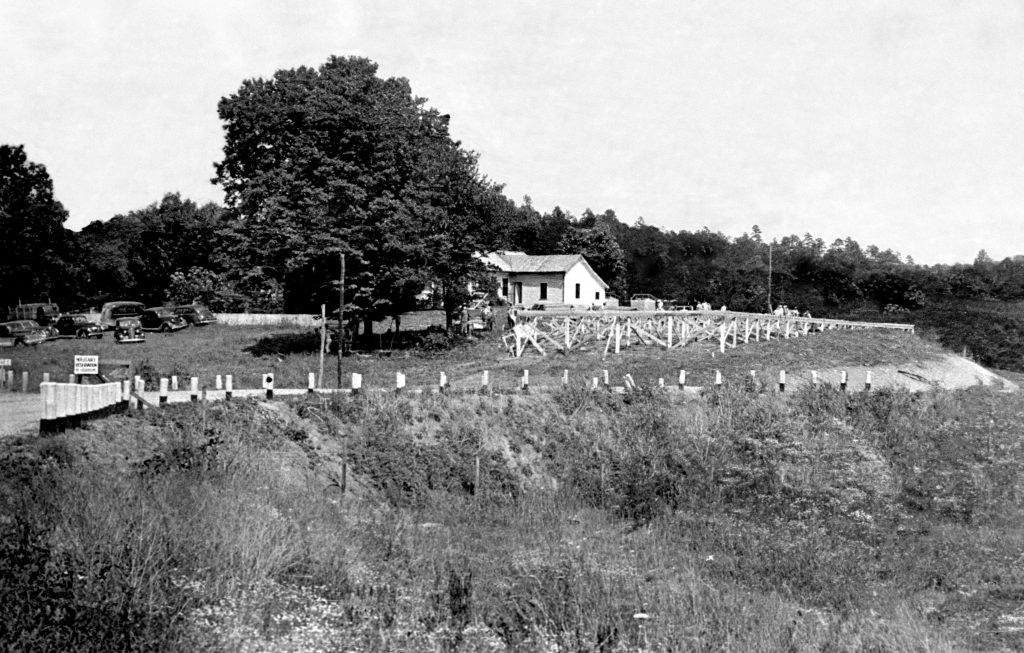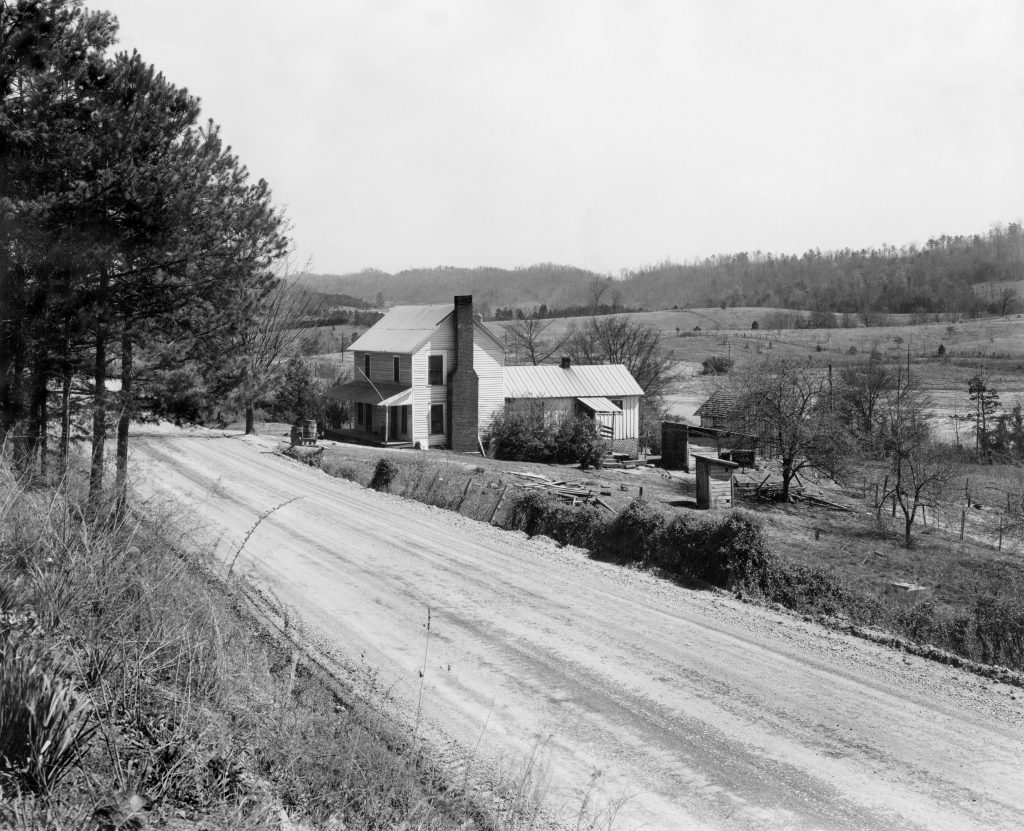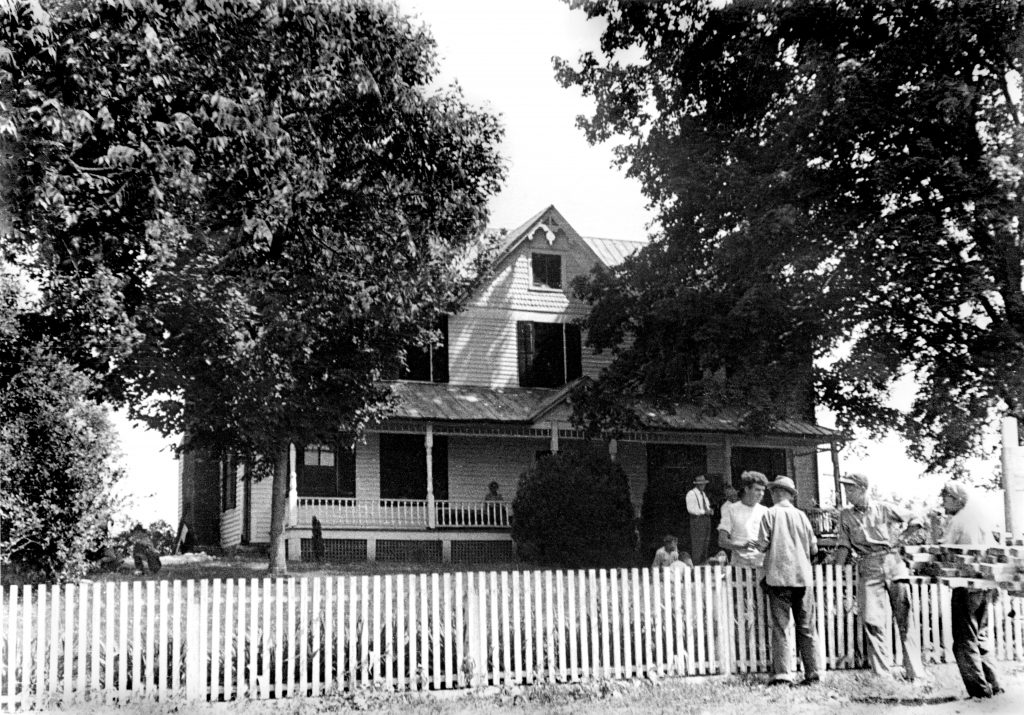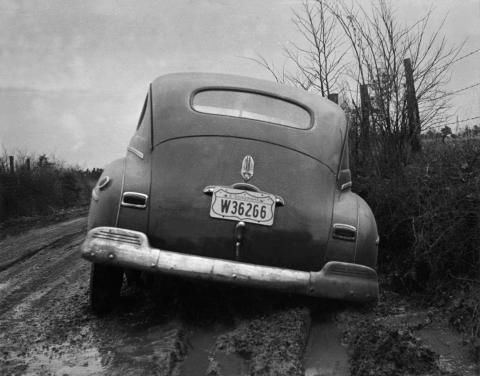During the Manhattan Project, about 3,000 people from rural eastern Tennessee were displaced for new research and development sites. Beginning in late 1942, the Manhattan Project developed into a national project with sites spanning across United States, eventually including more than 600,000 workers. On its own, Oak Ridge employed about 75,000 people. As director of the Manhattan Project, General Leslie R. Groves was instrumental in selecting and obtaining the land needed for the nuclear research and atomic bomb development sites, specifically Oak Ridge, Hanford and Los Alamos.
In order to provide sufficient resources, isolation, and facilities, the Manhattan Project requisitioned acres of land across the United States. The three major Manhattan Project sites of Oak Ridge, Hanford and Los Alamos required a total of 613,000 acres, which is almost two-thirds the size of Rhode Island, or three times the size of New York City. The size and scope of the Manhattan Project came with a hefty price tag of about $2 billion (in 1945 dollars). The cost of the Manhattan Project would have been approximately $30 billion today.
Although secrecy was a major factor in selecting project sites, complete isolation was not possible. Generations of families, farmers, and Native Americans resided in these chosen “isolated” areas. As a result of the Manhattan Project, these people were forced to abandon their homes and land, often without sufficient or even any compensation. The displacement had economic and emotional repercussions, as well as long-term environmental consequences.
The Manhattan Project Comes to East Tennessee
Oak Ridge was the first Manhattan Project site selected by General Groves. On September 19, 1942, Groves approved the acquisition of 59,000 acres of rural land along the Clinch River, a location twenty miles west of Knoxville, Tennessee. In his interview on the Voices of the Manhattan Project website, Oak Ridge historian Ray Smith noted that before the Manhattan Project, “This area was a small rural community of ridges and valleys here in East Tennessee.”
Smith estimated that there “were about 3,000 people that had to leave to make room for the approximately 60,000 acres that the government needed for the Manhattan Project.” While there were probably Native Americans who were also displaced from the Oak Ridge area, there are few records of their presence and displacement compared to those of local farming residents. As early as the 1700s, the Overhill Cherokee people had occupied areas of Eastern Tennessee, including near the Clinch River. Although most of the Cherokee people were forced to relocate to the Oklahoma Territory in 1838, some Cherokee later returned to Tennessee (Department of Energy, p. 4–30). 
According to Smith, the government began attaching notices to the doors of local residents in November 1942 and told them they had just a few weeks to vacate the premises. In her interview with the Atomic Heritage Foundation, Reba Holmberg shared the original notice signed by Lee A. Beeler, a clerk of the United States District Court, and given to her grandfather:
“You are hereby commanded to notify James M. Jett,” who was my grandfather, “or his tenant or agent that, heretofore, on the 15th day of February, 1943, a judgment of the declaration of taking, number fifteen filed in the above proceedings, gave the United States of America possession of tract #F567, containing 106.1 acres in Anderson County, Tennessee, in connection with the establishment of the Kingston Demolition Range. As of the 15th day of February, 1943—which tract of land is fully described in the declaration of taking, number fifteen on file in my office—and to forthwith vacate said premises immediately. You are further commanded that, if none of the parties are found in actual possession of said premises, to post a copy of this notice at a conspicuous place upon the premises and forthwith make the return of said services to the court.”
Reflecting on how locals responded to the notices, Holmberg explained that “everybody was very confused and very sad. It came so quickly, and everybody had to get out right away.” Holmberg said this urgency was especially difficult for her family because they received the notice in January. “They couldn’t take the crops out of the field. With high security, they were scared somebody would hide someplace among the bales of hay or the stacks of corn. So they were not allowed to take any of the crops.”
Challenges of Displacement
As in Hanford, the government’s compensation for the land was insufficient. The Washington Post reported that Curtis Allen Hendrix, the son of the so-called “Prophet of Oak Ridge,” only received $850 from the U.S. government for his sixty-acre farm. According to data from the U.S. Department of Agriculture’s National Agricultural Statistics Service, the average farm real estate value in 1942 for the forty-eight contiguous states was $34 per acre. At this price, sixty acres would have been valued at $1,920, about 2.25 times more than what Hendrix was compensated.
Hendrix’s story matches that of Holmberg. She shared, “They didn’t pay enough to replace the type of place that you had. We were very poorly paid for the land, and also we had a lot of people who were looking for land, so that made it hard.”

Displaced residents were also challenged by the logistics of relocating to another area. As Smith explained in his interview, “Many of them did not have automobiles. They did not have trucks to move their belongings. If they had an automobile, they might not be able to buy gas for it or tires. Those things were rationed.” Even though relocating was inconvenient and challenging, Smith remarked that residents were willing to quickly vacate their properties in order to help the war effort.
According to author Denise Kiernan, this was the “the third time that some families had to move. They had to move for the Great Smoky National Park, they had to move for the Norris Dam, and they had to move for Oak Ridge when it was constructed.” In These Are Our Voices: The Story of Oak Ridge, 1942 – 1970, John Rice Irwin noted that his family had moved to the Robertsville area after the Norris Dam flood. Citing his family’s limited time in the future Oak Ridge area, Irwin recalled: “While we knew well the distress of our neighbors, we ourselves were not as adversely affected” (Overholt, ed., 21). Regarding his neighbors, Irwin explained that it is important to “understand the cultural and ancestral roots to which rural folk become attached to the land after a few generations in order to understand the shock which results from such uprooting” (Overholt, ed., 21).
Many of the residents eventually came to work at the Oak Ridge facility. Holmberg said that she, her parents and grandparents all eventually worked on the Manhattan Project at Oak Ridge. While she and her family moved about six miles outside of Oak Ridge to Oliver Springs, Holmberg recalled other people settling all around Clinton, Norris, and Knoxville. These three cities are about fourteen, twenty, and twenty-five miles from Oak Ridge, respectively.
Additionally, Oak Ridgers who came from high education, urban areas and wealthier backgrounds sometimes looked down on the local people. Holmberg remembered, “A lot of people made remarks about the hillbillies who lived there, and it was kind of bad to have to listen to that. And it is true that not too many people went to college. But there were eighteen people in my high school class, and I think, out of that, about four of them went to college, which was a pretty good number.” Holmberg studied at the University of Tennessee before she began to work at the Y-12 Plant at Oak Ridge.

Legacy of Displacement
On top of immediate and forced relocation, local residents of Oak Ridge and their relatives have witnessed and experienced additional long-term effects of this Manhattan Project site. The main long-term effects have been related to changes in the environment. For more information about the environmental consequences about the Manhattan Project at Oak Ridge, please click here.
During World War II and wartime, in general, soldiers and civilians make sacrifices. In the case of residents of Oak Ridge, they gave up their homes and land for construction of Manhattan Project sites. Although Holmberg clarified that her grandfather “didn’t mope around about being displaced,” she remembered that it was still “very sad for her grandfather because he’d lived there since he and my grandmother were married. And he’d built barns and ponds and cultivated and developed his fields and fruit trees and all the things that you do over the years. And he had to leave it all that behind.”
The original residents of Hanford, the Manhattan Project’s future plutonium production site, also experienced displacement. In his book Atomic Spaces: Living on the Manhattan Project, Peter Bacon Hales argued that while government land acquisition in Hanford was similar to those in Tennessee, the procedures “if anything, were more draconian” (Hales, p. 61). Hales pointed to evidence including being given only two weeks to vacate their homes, the earliest checks taking three months to be issued and even fewer plots of available, arable land (Hales, p. 61).
Interpreting Manhattan Project History
On November 10, 2015, the National Park Service (NPS) and the Department of Energy signed an agreement that officially established the Manhattan Project National Historical Park with units at Oak Ridge, TN, Hanford, WA, and Los Alamos, NM. The agreement provided a division of roles in managing the new park. The NPS is the “storyteller” and interprets the Manhattan Project history while DOE maintains its properties that are part of the new park.
After convening meetings with scholars and the public, NPS published four major interpretive themes for the park. The first theme highlights displacement: “The “secret cities” created by the Manhattan Project, and the sacrifice and displacement connected to them, exemplified this massive wartime effort demonstrating remarkable opportunities to reflect on the extraordinary lengths to which people and nations go to protect their futures.”
For more information about visiting the Manhattan Project National Historical Park, please click here.





